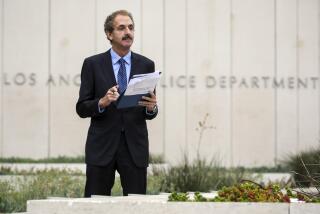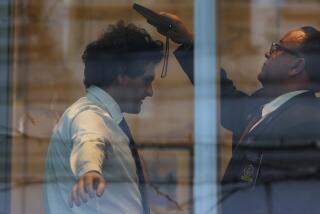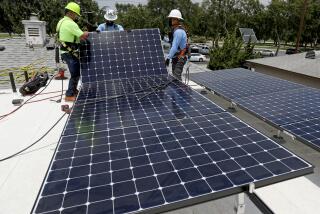Solar Energy Firm Generates Lawsuits in Tax Fraud Case
During a three-year period, Ernie Lampert’s United Energy Corp. sold 5,323 aluminum and silicon solar energy devices--more than $200 million worth--to generally well-heeled buyers looking for tax benefits.
The “solar power modules” on man-made, acre-sized ponds in Borrego Springs, Barstow and Davis, Calif., were touted as the most advanced electrical generating equipment on the market and promised to ease U.S. reliance on imported oil.
Lampert projected that sales of electric power and hot water created by the modules would reap a “30-year income flow” of more than four times the $30,000 to $40,000 purchase prices.
Perhaps even more alluring to buyers were the state and federal income tax credits and deductions that Lampert said were available.
But according to the Internal Revenue Service, Lampert’s operation was among the largest of a growing number of fraudulent tax-shelter schemes. A U.S. Justice Department lawsuit seeking to bar Lampert and his associates from future sales of “abusive” tax shelters is scheduled for trial Monday.
Some module buyers still are trying to recover their money plus damages, including 24 buyers from Orange County who sued Lampert.
In 1973, the IRS examined the returns of 400 taxpayers around the nation who were believed to have claimed benefits from abusive tax shelters. By 1981, the number had increased to 246,000, and through the first seven months of 1986, 372,000 cases were under examination. In 1985, the IRS recouped $2.5 billion in fines and penalties from individuals who had claimed benefits from abusive tax shelters.
In recognition of the growing problem, Congress passed legislation in 1982--the first year Lampert sold his modules--granting the IRS broad new enforcement powers to go after abusive tax-shelter promoters.
Since then, the IRS has requested the Justice Department to seek court injunctions barring more sales of abusive shelter investments in 167 cases. To date, the department has filed 103 lawsuits, including the Lampert-United Energy case.
However, unlike the vast majority of tax-shelter promoters under investigation by the IRS, Lampert has mounted a counteroffensive against the agency. He claims that overzealous IRS agents improperly used their new enforcement powers to ruin his corporation and punish him and the thousands of taxpayers and creditors who did business with United Energy.
Lampert and his associates sued the IRS, claiming that in late 1983--before the Justice Department concluded its investigation and long before federal or California authorities filed formal allegations--the IRS put United Energy on a blacklist, illegally leaked word to the financial community that the company was being investigated as an abusive shelter and disclosed United Energy trade secrets to business competitors.
As a result, Lampert said, module sales dried up and United Energy was forced into bankruptcy, where a court-appointed trustee stripped him of control, then took “the path of least resistance” and settled legal disputes between United Energy and the government.
Assistant U.S. Atty. Jay R. Weill concedes that before the government filed allegations in court, United Energy had appeared on a list of firms under investigation. But Weill said the list was for IRS internal use only.
Since United Energy’s bankruptcy, according to Lampert, he and his wife, Delphine, have been financially ruined, personally assessed $9.6 million in tax penalties and he has been labeled a fraud and a thief without being charged with a crime or granted a trial.
In 1974, Lampert, a former airline pilot, pleaded guilty to a misdemeanor of falsifying documents in certifying the completion of homes built by a firm that he owned in Alaska. The company pleaded guilty on a felony charge of obtaining money under false pretenses. Lampert paid a $15,000 fine, but said recently that he had taken responsibility for oversights by an employee.
Attorney’s Comment
“The IRS’ strategy (is) if you can destroy the business through bankruptcy, you’ll never go to trial,” said Lampert’s attorney, Montie S. Day of Oakland, a former criminal investigator with the IRS and a former special assistant in the U.S. attorney’s tax division in San Francisco. “The IRS has brought about the destruction of the company,” Day said.
“The government delays this thing (until) all that is left is the body of the corpse,” he said.
In its lawsuit filed in June, 1985, in San Francisco federal District Court, the Justice Department charged that United Energy is an abusive tax shelter because its solar modules were overvalued by at least 20 times and the units were not placed in service during the calendar year in which tax benefits were sought by the owners. As a result, the Justice Department said in a press release at the time, the U.S. Treasury lost $77 million in tax revenue in 1982 and 1983 alone.
The state Department of Corporations in July won a summary judgment against Lampert and his company, finding that they had sold unregistered securities and misrepresented the sales to the public. But Kenneth Christison, the attorney in that case for Lampert and other defendants, maintains that the court erred in its ruling and that the defendants never intended to defraud anyone. An appeal is planned.
Not Giving Up
Despite a bankruptcy trustee’s decision to sell off United Energy’s assets, San Diego Solar Concepts, a group representing 1,300 investors who bought 361 modules, still plans to make a success of Lampert’s solar energy farm, general partner Ed Ravenscroft said. The group is bidding on United Energy equipment at bankruptcy auctions.
“I think what the IRS did to United Energy was absolutely unconscionable. To allow it to happen in this country is a disgrace,” Ravenscroft said.
William T. Clary, who owns an Orange County electronics engineering consulting business, was one of numerous module purchasers earlier this year to whom Lampert offered trade-in credits for their old modules if they would buy Lampert’s new devices.
Offer Declined
Clary, who also is suing Lampert to recover his investment, declined the trade-in offer.
His module, Clary said, has “generated a lot more in lawyers’ fees than it generated in electricity.”
Since February, Lampert says he has been selling solar energy devices again, using a friend’s Santa Ana office to receive phone calls and mail. He has sold only two.
The Department of Corporations is closely monitoring Lampert’s new business, department attorney Mark J. Breckler said.
“When you walk into a broker and you want to sell him a piece of solar equipment with tax credits and you’re Ernie Lampert, they laugh at you,” Lampert said in a recent interview. “I cannot sell anything.”
That was not always the case.
Besides its solar farms, United Energy had 150,000 square feet of laboratories and manufacturing space in Foster City, Calif. Lampert’s “business plan” provided that the farms would be run by another Lampert firm, Renewable Power Corp., which would buy power and hot water from module owners to manufacture ethanol for fuel.
Lampert’s Position
“If I wanted to do an abusive tax shelter,” Lampert said, “I could have done it out of a 2,000-square-foot office on Wilshire Boulevard. We did not have a garage operation.
“The last thing I wanted to do, having been a person that walked the floors of Congress for eight years begging Congress for help for our industry, was to be the one that would be a violator of (those) very laws,” Lampert said.
In a typical United Energy sales agreement, a person bought a $40,000 module with a $14,500 down payment and signed a 30-year promissory note for $25,500 in monthly payments, secured only by the module. A buyer in the 50% tax bracket received federal and state tax credits and depreciation deductions of about $24,845 in the year the module was placed in service.
But U.S. Bankruptcy Court Trustee Frederick S. Wyle determined in January that “no real income has ever been generated . . . from the sale of energy or any other aspect of the solar farm operations.” Lampert maintains that many of the farms’ difficulties were due to technical shortcomings and problems with equipment suppliers.
The Justice Department also alleged that Lampert ran a “Ponzi scheme,” in which money from new investors was used by Renewable Power Corp. to make “power payments” to earlier investors, giving the false impression their units were profitable, according to Bankruptcy Court documents. The Department of Corporations also alleged in court that Lampert operated a Ponzi scheme but the charges were never proved.
Government Approval
However, on July 30, 1986, the Department of Corporations won a permanent order in Santa Clara County Superior Court requiring United Energy, the Lamperts and United Energy marketing directors Robert J. Burns of Clayton, Calif., and John P. Thorne of Foster City to obtain government approval before selling future securities, and barring them from misrepresenting the sales of securities. In granting the injunction, the court was required by law to impose penalties and ordered the Lamperts to pay $500,000, and Burns and Thorne to pay $25,000 each.
However, to the surprise of Department of Corporations attorney Breckler, the court refused to grant a state request that Lampert and the other defendants pay restitution to investors. Christison, Lampert’s attorney, said the judge’s decision to require no restitution was partly an acknowledgement by the court that the modules were not worthless, as authorities had maintained.
The Department of Corporations’ lawsuit never reached trial. The ruling was based on evidence reviewed by a court-appointed special master, according to Breckler.
At the heart of the dispute are the solar power modules, which capture sunlight on photovoltaic cells to produce electricity. Similar devices power space satellites, but Lampert acknowledged that the use of photovoltaic cells on Earth is still getting off the ground.
The modules were mounted on large pads that floated on one-acre ponds. By tracking the sun’s path from east to west, lens were supposed to focus sunlight onto the photovoltaic cells, a technique that was never completely successful at the farms.
“We have proved that every part of it works someplace,” Lampert said. “It’s just that we never got it all to work together at one time.”
Trustee’s Report
By the bankruptcy trustee’s accounting, more than $40 million of the $83 million received by United Energy went to manufacturing and construction of solar modules, the ponds and manufacturing equipment. About $7.3 million was spent on research and development, $12 million for operating and marketing costs, $12 million for sales commissions and $4.7 million in payments to module owners for “purported but fictional power sales” to public utilities.
Another $2.7 million went to Lampert in royalties above the $324,000 in salary and reimbursed expenses drawn over the life of the company by him and his wife. Another $2.6 million went for attorney and other professional fees, the trustee reported.
The trustee also reported that only 2,933 of the 4,101 modules United Energy claimed to have installed were located on the ponds. Lampert said the missing modules were removed to be repaired or replaced with newer, more efficient units.
C. Brent Cluff, a hydrologist at the Water Resources Research Center at the University of Arizona, holds the patents on the modules manufactured and sold by United Energy and received royalties on each unit sold. Cluff said Lampert “. . . got to the point that he stopped listening . . . to what technical and engineering people were saying.”
“In defense of Ernie,” Cluff said, “he was under unrealistic time restraints under the tax incentive laws (which required devices to be installed during the same calendar year in which tax benefits were claimed). If he had even until the following April 15 to get the systems installed, that would have made all the difference in the world. . . . “
Pending Lawsuit
Wyle, the bankruptcy trustee, alleged that $20 million in United Energy assets, including three condominiums valued at more than $600,000, four airplanes, two cars and nearly $2.7 million in “royalties” were “fraudulently or otherwise improperly transferred” to Lampert and Lampert-controlled entities. Wyle has recovered some of the assets, but has a pending lawsuit against Lampert to recover more.
In deciding to liquidate rather than reorganize the United Energy estate, Wyle concluded that the solar modules have, “for the most part, only scrap value.”
“The United Energy operation has been a dismal technical failure to date,” Wyle reported to Bankruptcy Court.
When Lampert still controlled the firm, United Energy filed two lawsuits seeking more than $250 million against the IRS for making allegedly unauthorized disclosures of its investigation and revealing company trade secrets. Wyle, who now controls United Energy, dismissed the suits this year as part of a settlement among the trustee, module purchasers, the IRS and the Department of Corporations.
“The trustee was under a lot of pressure to settle the estate,” said Lon Chandler, president of the Independent Power Producers Assn., a group of about 1,100 module owners. “Trade creditors just want things cleaned up.”
Chandler said that although 60% of his group agreed to the settlement, many are having second thoughts because of “discrepancies” in the trustee’s report.
Under the bankruptcy settlement, the United Energy estate avoids spending “energy and funds . . . defending the IRS lawsuit,” according to the trustee’s report.
No IRS Penalties
The IRS agreed to seek no penalties against United Energy and to grant module purchasers some tax benefits. Module purchasers who reject the settlement may end up “writing a check two to three times larger” for taxes and penalties than those who accept the settlement, the trustee determined.
Also as part of the settlement, the trustee agreed to accept the injunction on further sales sought by the Department of Corporations. And the department agreed to give the United Energy estate “any damages or restitution” it collects from the other defendants.
When the module owners of the Independent Power Producers Assn. agreed to the settlement this summer, they also signed over to the United Energy estate any claims that they had against the Lamperts, Burns, Thorne, the Renewable Power Corp. and the United Financial Corp., a company also headed by Lampert that borrowed money from United Energy and loaned it at a higher interest rate to the Renewable Power Corp.
But more than 90% of the 1,300 owners represented by the investors group San Diego Solar Concepts rejected the settlement, spokesman Ravenscroft said.
‘Nobody’s Convinced Me’
“Nobody’s convinced me the idea (Lampert) had down there won’t work,” Ravenscroft said.
There are still others attempting to recoup their money plus damages, including the 24 module buyers from Orange County who sued Lampert, his companies and associates. There are two more lawsuits in federal courts, and one attorney said, “You can expect a class-action suit.”
Amid these overlapping and often conflicting legal battles, Lampert insists that he has been the victim.
“We were only operating (solar farms) about 12 months before we started getting word . . . the IRS was saying that we might be abusive,” Lampert said. “There were brokers who were not dealing with us anymore . . . because they said they heard a rumor that the IRS said we were abusive.”
Asst. U.S. Atty. Weill said that during individual taxpayer audits, IRS agents may have revealed that United Energy was suspected of being an abusive tax shelter.
‘Entitled to Know’
“How else can we do business?” Weill asked. “Some auditor says, ‘We’re going to disallow a deduction because we think United Energy is an abusive tax shelter.’ I think everybody is entitled to know why they are being audited.”
Weill said it would have been impractical to wait for a court to rule that United Energy was an abusive tax shelter.
“With the statute of limitations (for tax audits) running, we don’t have much choice,” Weill said. “If we had waited, all these investors would have gotten away scot-free.”
Lampert also accuses the government of purposely delaying trial in its case against him, aware that bankruptcy and tax assessments would leave him hard-pressed to mount a defense. Weill said the government was ready for trial this spring after pretrial proceedings, but he blamed the delays on a crowded court calendar.
Last January, the Lamperts, Thorne and Burns sued the IRS a third time for allegedly making unauthorized disclosures when the government announced last year the details of its abusive tax shelter case. They seek $6 billion in damages.
The suit is “nonsense,” Weill said.
“Obviously,” Lampert said, “I do not believe that we will collect $6 billion.” (The amount is based on federal law that provides $1,000 in penalties for each unauthorized disclosure and an estimate that news accounts reached 6 million people.)
‘Hard to Tell’
Orange County attorney John Bisnar, who represents a group of module purchasers suing Lampert, acknowledged that “it’s hard to tell if he (Lampert) intended to rip them off.”
“A court only decides who should win or who should lose based on information presented to the court,” Bisnar said. “They (courts) don’t decide what the true facts are.”
Lampert, who is living with friends in San Diego, intends to move to a Santa Ana apartment soon. He expects to spend much of this month at the Justice Department trial in San Francisco.
“If I stole money,” Lampert said, “why would I still be here, still fighting, still forcing this thing to court to prove it’s right? Why aren’t I in Brazil spending it and having a good time?
As for the future: “The sun is going to shine the rest of my life and I’ll probably figure out how to sell somebody a solar collector and I’ll probably eat off of (the profits).”
More to Read
Inside the business of entertainment
The Wide Shot brings you news, analysis and insights on everything from streaming wars to production — and what it all means for the future.
You may occasionally receive promotional content from the Los Angeles Times.










